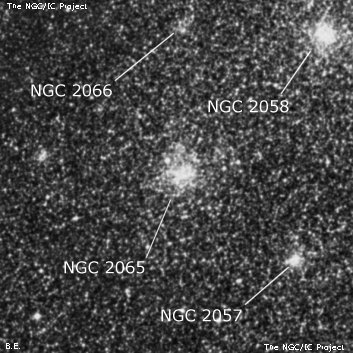
James Dunlop probably discovered NGC 2065 = D 105 on 24 Sep 1826 and described "a round well-defined nebula, 25" diameter." He made two observations and his position is 9' SE of this cluster. On 11 Oct 1836, John Herschel found the cluster and reported h2938 as "pB; R; last of group of 6. Pl IV, fig 9." Three sweeps later he noted "B; the 6th of a group of 7." His position and sketch is accurate. He questioned if this object was D 103, though D 105 seems a better match.
The entire group of clusters (NGC 2046, 2047, 2057, 2058, 2059, 2065, 2066) was sketched by Le Sueur on 7 Feb 1870, Joseph Turner on 26 Apr 1876 and Pietro Baracchi on 18 Dec 1884 using the 48" Great Melbourne Telescope. Le Sueur's and Turner's sketches were published in "Observations of Southern Nebulae made with the Great Melbourne Telescope 1869 - 1885" on plate IV, figure 32 and figure 33.
600/800mm - 24" (4/9/08 - Magellan Observatory, Australia): at 260x, this LMC cluster appeared very bright, fairly large, round, 1.2' diameter, weak concentration. With averted vision, the surface is mottled and the outer halo increases to at least 1.5'. The cluster appeared very lively at 350x with a few stars just on the verge of resolution. At this power the halo appeared up to 1.8' in diameter. A mag 12 star is at the NE edge and two mag 13/13.5 stars lie ~1.5' WNW. Eight NGC clusters reside in this one field with four other clusters within 6': NGC 2057 4' SW, NGC 2066 4.2' N, NGC 2072 4' E and NGC 2058 5.8' NW!
Notes by Steve Gottlieb